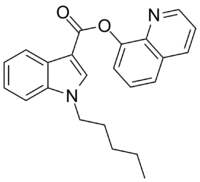

 | |
| Legal status | |
|---|---|
| Legal status |
|
| Identifiers | |
| |
| CAS Number | |
| ChemSpider | |
| UNII | |
| CompTox Dashboard (EPA) | |
| ECHA InfoCard | 100.233.114 |
| Chemical and physical data | |
| Formula | C23H22N2O2 |
| Molar mass | 358.441 g·mol−1 |
| 3D model (JSmol) | |
| |
| |
PB-22 (QUPIC, SGT-21or1-pentyl-1H-indole-3-carboxylic acid 8-quinolinyl ester) is a designer drug offered by online vendors as a cannabimimetic agent, and detected being sold in synthetic cannabis products in Japan in 2013.[1][2] PB-22 represents a structurally unique synthetic cannabinoid chemotype, since it contains an ester linker at the indole 3-position, rather than the precedented ketone of JWH-018 and its analogs, or the amide of APICA and its analogs.
PB-22 has an EC50 of 5.1 nM for human CB1 receptors, and 37 nM for human CB2 receptors.[3] PB-22 produces bradycardia and hypothermia in rats at doses of 0.3–3 mg/kg, suggesting potent cannabinoid-like activity.[3] The magnitude and duration of hypothermia induced in rats by PB-22 was notably greater than JWH-018, AM-2201, UR-144, XLR-11, APICA, or STS-135, with a reduction of body temperature still observable six hours after dosing.[3] One clinical toxicology study found PB-22 to be the cause of seizures in a human and his dog.[4]
PB-22 was originally developed by New Zealand legal highs company Stargate International in 2012 as SGT-21, intended to be a structural hybrid of QMPSB and JWH-018.[5] However, no intellectual property protection was applied for and the compound quickly became subject to widespread grey-market sales outside the control of the inventors.
A forensic standard of PB-22 is available, and the compound has been posted on the Forendex website of potential drugs of abuse.[6]
As of 9 May 2014, PB-22 is no longer legal in New Zealand.[7]
In January 2014, PB-22 was designated as a Schedule I controlled substance in the United States.[8][9]
Florida also has banned PB-22.[11]
Since 13 December 2014 it is also illegal in Germany because of adding the substance to the BtMG Anlage II.
As of October 2015 PB-22 is a controlled substance in China.[12]